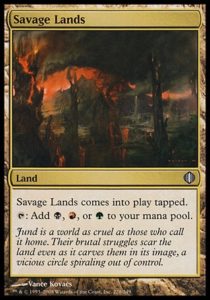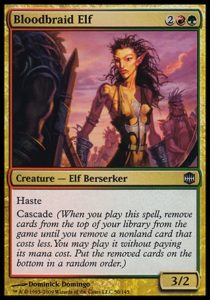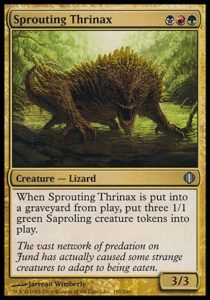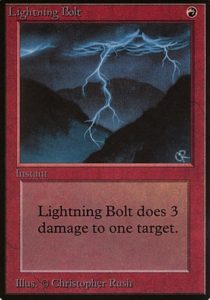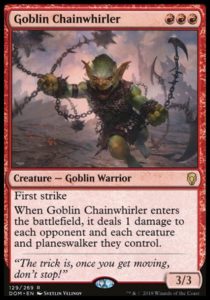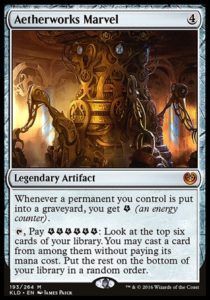The Pro Tour has come and gone and seven of the top eight decks were heavy or mono-red, with Wyatt Darby taking the tournament down with Mono Red. This continues a trend of red, aggressive dominance across several Standard Pro Tours: PT Aether Revolt’s top 8 had 6 copies of Mardu Vehicles and was won by Lucas Esper Berthoud on it. PT Hour of Devastation had 5 copies of Ramunap Red and was won by Paulo Vitor Damo da Rosa on it. Even PT Ixalan, which was won by Energy (with four copies in the top 8) also saw Ramunap Red and Mardu Vehicles featured on Sunday. So, why is red so often ascendant nowadays? How does it persist despite being a long-known quantity and weathering the bans of Smuggler’s Copter, Ramunap Ruins, and Rampaging Ferocidon?
The answer lies in Jund.
The Essence of Jund
Jund is a goodstuff deck. It combines powerful threats, resilient threats, threats which produce advantage, and the best disruption available. It has game against everything, is a quintessentially fair deck, and fares worst when powerful unfair decks exist.
Looking at the Pro Tour, some flavors of red skewed much more aggressive than others, but all bore features more reminiscent of Jund or midrange decks than traditional aggressive decks. Traditional aggro decks are about being low to the ground, pushing in damage quickly, and having some form of reach when your opponent starts to stabilize. They often topdeck very poorly in the late game and can be stymied by removal backed up by disruption or lifegain. However, contemporary red (sometimes with a light splash of black) happens to have all the tools Jund needs three colors to access.
Aggressive Advantage
Jund decks have Bloodbraid Elf and Dark Confidant: threats which provide card advantage. Chandra, Torch of Defiance, Glorybringer, Goblin Chainwhirler, Bomat Courer, and Screapheap Scrounger all provide value immediately or over time.
Resilient Threats
Jund decks have Tarmogoyfs and Sprouting Thrinaxes: undercosted threats with built-in resilience. Heart of Kiran, Hazoret, the Fervent, Rekindling Phoenix, Chandra, Torch of Defiance, and Scrapheap Scrounger are all above-the-curve threats that resist several forms of removal. In fact, most of them are weak to different kinds of efficient disruption, so opponents are forced to pay extra for expensive, all-purpose, exiling answers like Cast Out and Vraska’s Contempt. These answers essentially never trade up in mana, and many of red’s threats can win the game by themselves, so the deck is hard to disrupt.
And while we’re on that subject…
The Best Disruption
Jund has Lightning Bolts, Terminates, and Thoughtseizes: the most efficient disruption available. Abrade, Lightning Strike, Magma Spray, Unlicensed Disintegration, and Vraska’s Contempt comprise some of the most mana-efficient and powerful removal available, with Abrade being the likely best removal spell in Standard. In addition, black/red has access to the best reach in Unlicensed Disintegration, Cut // Ribbons, and Chandra, Torch of Defiance (who you’ll notice has cropped up in every category thus far).
Format Warping
When Jund decks are good, they shape the entire metagame around them. You either need to go underneath them, do something substantially more powerful, or disrupt their ambitious manabases. Jund has game against everything because it’s a combination of excellent threats and excellent removal. We’re looking at a particularly dangerous version of Jund because it resists all three normal methods of counterattack.
Goblin Chainwhirler completely reshapes the Standard environment by itself. It single-handedly invalidates token strategies and hyperfast aggro while attacking Llanowar Elves-based ramp and midrange decks. It and red’s other disruptive cards make it very, very difficult to go under Red Jund.
Red having access to two of the best Planeswalkers in Standard, Chandra, Torch of Defiance and Karn, Scion of Urza, and its plethora of resilient and advantageous threats means that the deck is pre-boarded to fight control decks (in addition to aggro). Every card from Red needs to be answered and many resist the normal X-for-one removal spells like Fumigate.
Finally, it’s basically impossible the attack the manabase of Red. Setting aside that Magic tends to be better when land destruction is weak, there’s not much of a manabase to disrupt. Sure, Goblin Chainwhirler‘s red-intensive mana cost would normally restrict it to weaker monocolor decks, but red doesn’t need to branch out much to get everything it needs. It already has the best monocolor Planeswalker in Standard and every single color has access to cards like Heart of Kiran and Scrapheap Scrounger.
And that brings us to where we are. There are sufficient strong red and colorless cards that red decks get to be Jund. Some cards, like Chandra, Torch of Defiance, combine disruption, card advantage, and a resilient threat in a single card. This iteration of Jund is resilient to the archetypes that tend to be able to beat Jund (since the banning of Aetherworks Marvel, there has been no truly unfair combo deck, which is a good thing for Standard but also for Jund decks), it has main deck answers to aggro and control, and relies on a manabase that it rarely loses to. To boot, it even has flood protection in Canyon Slough, Chandra, Torch of Defiance, Karn, Scion of Urza, and Scrapheap Scrounger.
When Jund is Top Dog…
Midrange decks like Jund are fair. They play the best rate cards available. It just so happens that in the current Standard environment, red doesn’t have to branch out much, if at all, to get an entire deck chock full of above-rate cards. This might be the first time ever that Jund doesn’t lose to its own mana base or be open to being punished for its mana base. There is no single card that simply shouldn’t have been printed—sure, Hazoret, the Fervent is ridiculous, but Hazoret on her own is a card that the metagame can and has shifted to answer.
I think the ascendancy of red is due to two factors interacting with each other. First, disruption is still catching up with threats. There is still a wide diversity of answer-resistant threats in Standard, so it’s hard for a control deck to cleanly answer Jund, even with cards like Vraska’s Contempt, Seal Away and Settle the Wreckage—Red can go underneath the expensive burn spells and trades evenly on mana for the most powerful answers.
The second factor is Kaladesh. I mean no disrespect to R&D (getting Standard just right is an impossible balancing act), but I wouldn’t be surprised if Kaladesh goes down in history as the worst-developed set since Urza’s Saga. Yes, Mirrodin was hugely problematic, but that’s the set where R&D learned the danger of powerful, colorless cards and mechanics that circumvent the mana system. Kaladesh repeated that mistake twice, with its powerful colorless artifacts (particularly Vehicles) and the Energy mechanic. Scrapheap Scrounger, Bomat Courier, Chandra, Torch of Defiance, and Heart of Kiran have been featured at the top levels of play consistently since their printing—they play together well and attack along very different axes, demanding very different (or expensive, all-purpose) answers. None of these cards is problematic in its own right, but put together in a format lacking incredibly powerful and versatile answers like Path to Exile or even Grasp of Darkness, they’re collectively far too much.
I really don’t want to see more Standard bannings. I wouldn’t even bet on them happening as we wait for Kaladesh to finally, finally rotate out. We’ve seen more rounds of bannings since Kaladesh than we have in any Standard season ever? Standard needs to be healthy for Magic to be healthy, and unfortunately, Kaladesh’s bold experiments unleashed a host of problems. Dominaria shows a wealth of improvement, as well as its own startlingly powerful cards in Llanowar Elves, Karn, Scion of Urza, and Teferi, Hero of Dominaria. It’ll just take a bit more time for Goblin Chainwhirler to lose some of its best buddies.
And, as always, thanks for reading.
—Zachary Barash
Zachary Barash is a New York City-based game designer. He works for Kingdom Death: Monster, has a Game Design MFA from the NYU Game Center, and does freelance game design. When the stars align, he streams Magic.
His favorite card of the month is Goblin Fireslinger. It’s brutally simple and quite weak but it just plays perfectly with Bloodthirst (which it was designed to do). And it can be surprisingly potent clock when games go long. It pulls a whole lot of work for a simple common.

